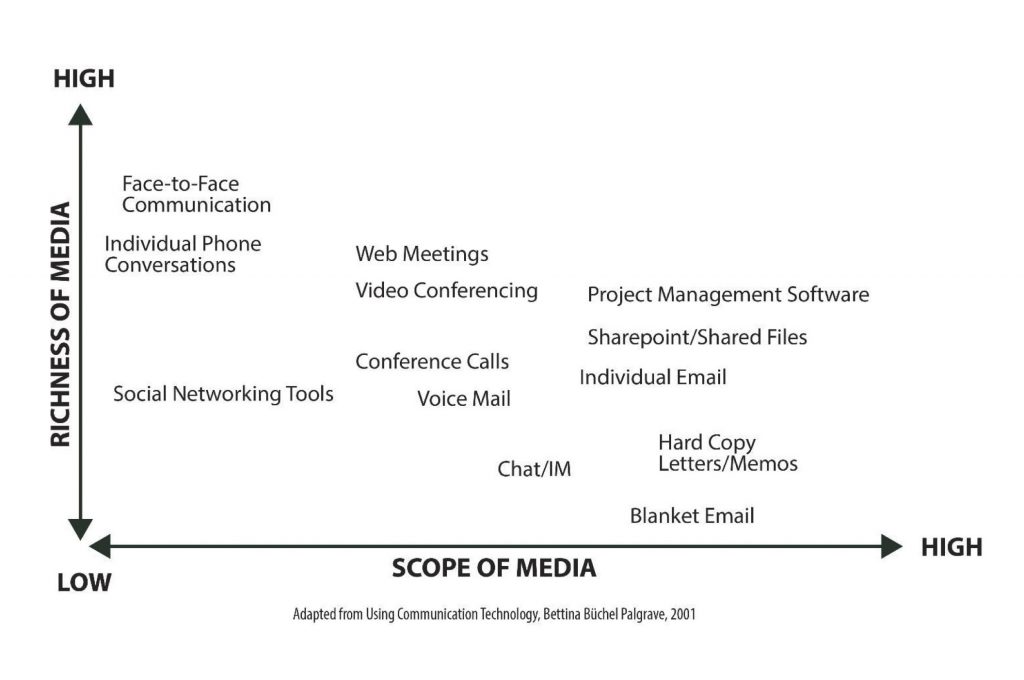Why Richness and Scope Matter to Long-Distance Leaders
With the ever-increasing role of remote workers, we’re pleased to bring you a guest post from Wayne Turmel, co-author of The Long-Distance Leader: Rules for Remarkable Remote Leadership.
Technology is critical to leading a long-distance team. Email, meeting tools, network and file access—our jobs would be impossible (or at least really difficult) without it. But nearly as important as knowing which tools to use, is being confident you’re using the right tool for the right job.
In The Long-Distance Leader: Rules for Remarkable Remote Leadership, Kevin Eikenberry and Wayne Turmel offer a simple guide to choosing the appropriate technology. Based on research from Bettina Büechel, it suggests finding the balance between richness and scope.
Richness is the wealth of communication cues at work to ensure understanding in any communication. A face-to-face, in-person conversation is a good example. Not only can you see and hear in real time, but you’re seeing the visual cues on the person’s face, their body language, the tone of their voice, and they can do the same. There’s a really good chance you’re communicating clearly AND being understood, with plenty of time to adjust your message if needed. The problem is that we can’t go person to person on our team… and not all messages require that level of understanding.
Scope is the opposite. Email is a great example. You can get the same message in the same way over time and distance very quickly and efficiently. The good news is that hundreds of people can receive identical messages. Of course, it lacks richness—it may be misunderstood or action might not be taken, and you have no way of knowing if that’s happening until it’s too late.
 Neither richness or scope are good or bad on their own. The question is, “Are we using the right tool at the right time?” For example, if a leader knows they should have a difficult conversation with someone (the richer the better when addressing a performance issue, for example) it might be more convenient and far less stressful to just send an email or a voicemail after hours. True, the message was communicated, but it wasn’t nearly as effective as it could be. This should call for a richer conversation; in-person if possible. If not, you might want to use voice and webcam in a quiet place, rather than simply make a crackly cell phone call from an airport departure lounge.
Neither richness or scope are good or bad on their own. The question is, “Are we using the right tool at the right time?” For example, if a leader knows they should have a difficult conversation with someone (the richer the better when addressing a performance issue, for example) it might be more convenient and far less stressful to just send an email or a voicemail after hours. True, the message was communicated, but it wasn’t nearly as effective as it could be. This should call for a richer conversation; in-person if possible. If not, you might want to use voice and webcam in a quiet place, rather than simply make a crackly cell phone call from an airport departure lounge.
As The Long-Distance Leader makes clear, this is fairly obvious if one takes the time to think about it, but how many of us take that precious time? We’re often too busy to stop and give mindful attention to the tools we use. We often do what’s seemingly quicker—even if it might be less effective in the long run—or use the tools we’re most comfortable with. An example of this is not taking advantage of the innate richness of a webcam conversation because we’re not comfortable seeing ourselves on camera. Instead, we settle for a voice conversation that doesn’t allow for visual cues to judge whether the other person is really understanding or buying into the discussion.
This is just one of the models Eikenberry and Turmel use to demonstrate the simple but not always easy or obvious ways to address the challenges of leading people, projects or teams from a distance. You can learn more in The Long Distance Leader: Rules for Remarkable Remote Leadership.
Wayne Turmel is the co-founder (along with Kevin) of The Remote Leadership Institute and the author of many books, including ATD’s 10 Steps to Successful Virtual Presentations.

Wayne and Kevin Eikenberry have co-authored the definitive guide for remote leaders, The Long-Distance Leader: Rules for Remarkable Remote Leadership.







0 Comments